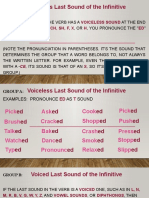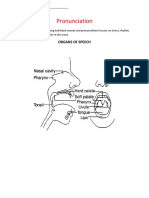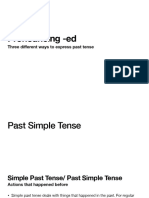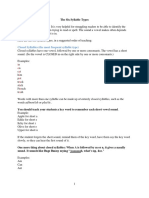Pronunciation Rules Regular Past Tense
Pronunciation Rules Regular Past Tense
Uploaded by
Pamela HernandezCopyright:
Available Formats
Pronunciation Rules Regular Past Tense
Pronunciation Rules Regular Past Tense
Uploaded by
Pamela HernandezOriginal Title
Copyright
Available Formats
Share this document
Did you find this document useful?
Is this content inappropriate?
Copyright:
Available Formats
Pronunciation Rules Regular Past Tense
Pronunciation Rules Regular Past Tense
Uploaded by
Pamela HernandezCopyright:
Available Formats
REGULAR PAST TENSE
All regular verbs in English form their past tense by adding “ed” to the base form. You should
observe these SPELLING RULES: a) If the verb ends in “e” only add “d” (change- changed,
chase-chased) b) If the verb ends in “y” preceded by a consonant, the “y” is changed to “i”
before adding “ed” (study-studied, cry-cried); c) Verbs of one syllable ending in one consonant
preceded by one vowel, double the final consonant before adding “ed” (planned, jog jogged);
when the verbs have more than one syllable and end in one consonant preceded by a vowel,
you have to check where THE STRESS falls, if it falls on the last vowel, you double the last
consonant (refer-referred, prefer-preferred) if the stress falls on another vowel, you do not
double the last consonant (listen-listened, order-ordered)
THE PRONUNCIATION OF THE “ED” HAS THREE DIFFERENT SOUNDS:
1. When in the base form a verb ends in SOUNDS / t / or / d /, the ED sounds like /ed, id/
Accept accepted need needed
Complete completed end ended
2. When in the base form a verb ends in SOUNDS / s, sh, ch, x, f, p, k /, the ED sounds like
/t/
Dance danced cough coughed
Finish finished stop stopped
Watch watched work worked
Fix fixed
3. When in the base form a verb ends in sounds /n, r, v, a vowel sound, etc* / the ED
sounds
like / d /
Clean cleaned love loved
Answer answered hurry hurried
EXERCISE:
WRITE THESE VERBS IN THE CORRESPONDING COLUMN ACCORDING TO THEIR
PRONUNCIATION IN PAST TENSE.
Date expect paint plant point
Ask cook dress erase rent
Travel show remember play plan
Order wash walk waste want
Open live push laugh wait
Jump help listen learn arrive
Close add agree bake bark
Believe brush burn call chase
Celebrate climb copy count crash
Cry cross decide decorate die
Discuss drop earn expect explain
Faint invent kiss knock land
Like mail need order phone
Pull repeat start talk test
Wait study practice graduate enter
/ ed – id / /t/ /d/
Dated asked traveled
You might also like
- (The Colloquial Series) Zaure Batayeva - Colloquial KazakhNo ratings yet(The Colloquial Series) Zaure Batayeva - Colloquial Kazakh327 pages
- Lesson Plan Pronunciation Project: There Are Different Ways To Pronounce ThemNo ratings yetLesson Plan Pronunciation Project: There Are Different Ways To Pronounce Them5 pages
- Pronunciation of - Ed Ending of Regular VerbsNo ratings yetPronunciation of - Ed Ending of Regular Verbs2 pages
- Plural and Past Tense Markers' Pronunciation in English Phonetics67% (3)Plural and Past Tense Markers' Pronunciation in English Phonetics3 pages
- Work, Worked, Worked: How To Pronounce - EdNo ratings yetWork, Worked, Worked: How To Pronounce - Ed2 pages
- 2 - Materials - Pasca - English - DR Hasan KhalawiNo ratings yet2 - Materials - Pasca - English - DR Hasan Khalawi63 pages
- Ed Pronunciation British English Student Ver2No ratings yetEd Pronunciation British English Student Ver22 pages
- REGULAR PAST SIMPLE (Spelling and Pronunciation)No ratings yetREGULAR PAST SIMPLE (Spelling and Pronunciation)4 pages
- Past Tense Pronunciation For Regular Verbs ColorNo ratings yetPast Tense Pronunciation For Regular Verbs Color1 page
- Past Tense Pronunciation For Regular Verbs Color (Grammar Rules: Unit 2)No ratings yetPast Tense Pronunciation For Regular Verbs Color (Grammar Rules: Unit 2)1 page
- 1_15 Advanced_ Intermediate Phonics (4)No ratings yet1_15 Advanced_ Intermediate Phonics (4)27 pages
- Pronunciation of Ed Endings Fun Activities Games Games Pronunciation Exercises 9113No ratings yetPronunciation of Ed Endings Fun Activities Games Games Pronunciation Exercises 91133 pages
- 02 Tlaxcala Reading and Ed Pronunciation. ComprimidoNo ratings yet02 Tlaxcala Reading and Ed Pronunciation. Comprimido4 pages
- Webster's Word Power Essential English Words: Learners' DictionaryFrom EverandWebster's Word Power Essential English Words: Learners' DictionaryNo ratings yet
- Mastering French: A Guide to Learning the Language: The Language CollectionFrom EverandMastering French: A Guide to Learning the Language: The Language Collection5/5 (1)
- BRP Hiligaynon Script S5-L13 QAed With VGNo ratings yetBRP Hiligaynon Script S5-L13 QAed With VG25 pages
- Chapter 3 Phonological Rules and Phonological ProcessesNo ratings yetChapter 3 Phonological Rules and Phonological Processes4 pages
- Let's Get Started - Book 1 - Introduction and Sample Pages100% (1)Let's Get Started - Book 1 - Introduction and Sample Pages49 pages
- Mahatma Gandhi University Syllubus For English Language and Literature (Model 1) 2017 Admissions Onwards SchemeNo ratings yetMahatma Gandhi University Syllubus For English Language and Literature (Model 1) 2017 Admissions Onwards Scheme66 pages
- Chapter 2 Description and Classification of English ConsonantsNo ratings yetChapter 2 Description and Classification of English Consonants16 pages
- Imitation of Second Language Sounds in Relation To L2 Perception and ProductionNo ratings yetImitation of Second Language Sounds in Relation To L2 Perception and Production18 pages
- 2.mock Based On Pattern 2015 Clerk PrelimsNo ratings yet2.mock Based On Pattern 2015 Clerk Prelims8 pages
- Easy Spanish Phrase Book Conversational SpanishNo ratings yetEasy Spanish Phrase Book Conversational Spanish113 pages
- The Sound Systems Between English and Arabic: A Comparative Study Written by Abdulbaseer Eid94% (31)The Sound Systems Between English and Arabic: A Comparative Study Written by Abdulbaseer Eid50 pages
- Phonics and Stuff - CKLA - Book 0-1 - Pet FunNo ratings yetPhonics and Stuff - CKLA - Book 0-1 - Pet Fun5 pages

























































































